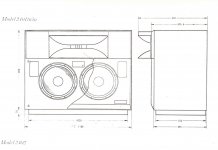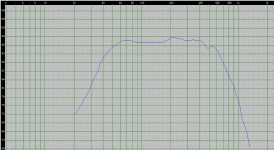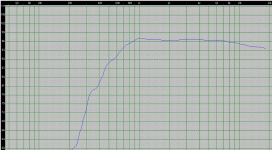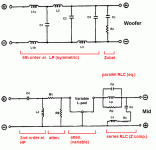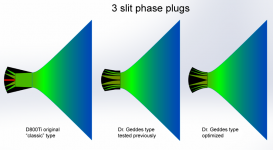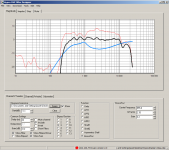Seven please
No drum kit in that song. Maybe track eight.
Jean,
My biggest concern in designing a passive crossover is accounting for the delay in HF arrival with respect to the woofer acoustic center.
TAD tackled this in their TSM series (aka 2401/2402) monitors by employing an asymmetric crossover, which I have recently reverse-engineered, based on the published schematics and frequency-response graphs.
Such crossover appears to work as follows:
Crossover frequency Fx = 650Hz
LF) 6th order electrical Low Pass > 6th order Linkwitz-Riley target @ Fx; normal polarity connection (+); phase @ Fx = -6*45=-270º
HF) 2nd order electrical High Pass > 3rd order Butterworth target @ Fx; inverted polarity connection (-); phase @ Fx = 3*45º-180º=-45º; level = -1dB
LF-HF offset set for phase match at Fx = (270-45)º = 225º = (5/8)*c/Fx = 5/8*34400/650 = 33cm
In attachment: (i) a technical drawing of the TSM-1 (2401) monitor, (ii) the filtered Woofer LP response, (iii) the filtered Compression Driver + Horn HP response, (iv) the passive crosssover schematic.
I actually plan to make a three-way crossover for my own high efficiency system soon, based on this design (by adding a super-tweeter and second crossover point at Fx2 = 10*Fx).
Cheers,
Marco
Attachments
Hello,
What you describe is only phase match but that does not means that this crossover + offset between loudspeakers is in anyway able to achieve linear phase linear phase which is needed for a constant group delay and optimal impulse response.
If we imagine to obtain the time delay required to compensate an offset around 33 centimeters through the crossover, we need a low-pass (Bessel for example) of a very degree (17 to 20 degree) with the cut-off frequency you indicated.
I guess that in the TAD monitor the goal was only to obtain a phase match and a smootgh variation of the lobing with frequency, not an optimal Impulse Response.
Best regards from Paris, France
Jean-Michel Le Cléac'h
What you describe is only phase match but that does not means that this crossover + offset between loudspeakers is in anyway able to achieve linear phase linear phase which is needed for a constant group delay and optimal impulse response.
If we imagine to obtain the time delay required to compensate an offset around 33 centimeters through the crossover, we need a low-pass (Bessel for example) of a very degree (17 to 20 degree) with the cut-off frequency you indicated.
I guess that in the TAD monitor the goal was only to obtain a phase match and a smootgh variation of the lobing with frequency, not an optimal Impulse Response.
Best regards from Paris, France
Jean-Michel Le Cléac'h
TAD tackled this in their TSM series (aka 2401/2402) monitors by employing an asymmetric crossover, which I have recently reverse-engineered, based on the published schematics and frequency-response graphs.
Such crossover appears to work as follows:
Crossover frequency Fx = 650Hz
LF) 6th order electrical Low Pass > 6th order Linkwitz-Riley target @ Fx; normal polarity connection (+); phase @ Fx = -6*45=-270º
HF) 2nd order electrical High Pass > 3rd order Butterworth target @ Fx; inverted polarity connection (-); phase @ Fx = 3*45º-180º=-45º; level = -1dB
LF-HF offset set for phase match at Fx = (270-45)º = 225º = (5/8)*c/Fx = 5/8*34400/650 = 33cm
In attachment: (i) a technical drawing of the TSM-1 (2401) monitor, (ii) the filtered Woofer LP response, (iii) the filtered Compression Driver + Horn HP response, (iv) the passive crosssover schematic.
I actually plan to make a three-way crossover for my own high efficiency system soon, based on this design (by adding a super-tweeter and second crossover point at Fx2 = 10*Fx).
Cheers,
Marco
Hello,
What you describe is only phase match but that does not means that this crossover + offset between loudspeakers is in anyway able to achieve linear phase linear phase which is needed for a constant group delay and optimal impulse response.
If we imagine to obtain the time delay required to compensate an offset around 33 centimeters through the crossover, we need a low-pass (Bessel for example) of a very degree (17 to 20 degree) with the cut-off frequency you indicated.
I guess that in the TAD monitor the goal was only to obtain a phase match and a smootgh variation of the lobing with frequency, not an optimal Impulse Response.
Best regards from Paris, France
Jean-Michel Le Cléac'h
Dear Jean-Michel,
thank you for your contribution.
In a nutshell, yes, I agree completely.
The TAD crossover does not fully compensate for the physical offset between the woofer and compression driver. Moreover, by employing a L-R low pass instead of a Bessel one, the group delay (GD) of the woofer is not constant below Fx.
Ideally, one would like to achieve GD(LP)-GD(HP) = physical offset, with a constant GD for both crossover branches at and in the vicinity of Fx. That, and of course a quasi-flat summation and good phase match.
Still, the TAD crossover may be regarded as a reasonably good compromise, given that it does produce a flat summation and good phase match, despite the rather large 33cm offset dictated by the physical dimensions of the TH-4001 horn.
I am personally still investigating alternatives.
One such alternative which I have found to work quite nicely, at least in theory, is a 6th order Bessel LP + 2nd order Butterworth HP, both set so they are -6dB at Fx, with reversed polarity on the HP and an offset = 0.4*c/Fx.
For the same Fx = 650Hz as the TAD monitors, one gets offset = 22cm (good but not quite as much as with the TAD crossover, so the horn would have to sit forward with respect to how it is deployed in the TSM monitors).
One further potential problem, though, is that it is sometimes hard to achieve a true acoustical 2nd order HP with a typical horn...
On the positive side, this alternative crossover does meet the GD(LP)-GD(HP) = physical offset condition, and still sums flat.
I'll keep simulating other alternatives. For example, one could use an even steeper Bessel LP (e.g. 8th order - beyond that the insertion losses would be a major drawback, I guess), paired with some reasonable HP (2nd or 3rd order), to try and increase the offset while still achieving a flat summation, good phase match at Fx and ~constant GD difference.
Cheers,
Marco
So far I have been very happy with the SEOS waveguides - in addition to IMO measuring, integrating and sounding very well, they are beatifully made. However, I feel the potential of the largest ones could have been even better released if allowed for larger drivers than the 1"-ers.
I would therefore suggest a little race to see how many that could be interested in the SEOS 15, 18 or 21 with 1,4" and/or 1,5" throats. If the interest is large enough I feel quite confident Jzagaja would make a mold or two
Personally I would love to have the SEOS 18 and 15 with 1,4" throat (Radian 951Be / 0º exit ). If possible I would also like to have the SEOS 18 for 1.5" JBL 2447 (unfortunately I don't know the exit angle).
Cheers
I would therefore suggest a little race to see how many that could be interested in the SEOS 15, 18 or 21 with 1,4" and/or 1,5" throats. If the interest is large enough I feel quite confident Jzagaja would make a mold or two
Personally I would love to have the SEOS 18 and 15 with 1,4" throat (Radian 951Be / 0º exit ). If possible I would also like to have the SEOS 18 for 1.5" JBL 2447 (unfortunately I don't know the exit angle).
Cheers
Hmm.. only me that would like to have SEOS with larger throat?
I've got a few 1.4" and 2" throad compression drivers, but I'll count myself as one of those not interested in a larger diameter throat SEOS.
Hello,
I'm not expert in horns, drivers and a I've a question in my mind:
at the moment I'm using a Radian 475PB in my Sterling Silver Iris clone connected with a serie 7,5 ohm resistor to match the sensivity, now I'd like to buy a seos 12" plastic horn and try to use a lower crossover frequency (about 1,2Khz or a bit less)with a 12db cut.
I'm using a 8W SE amp for the woofer and tweeter, so the power is limited.
Do you think that the Radian Driver could be any problem of power handling and linear movement? And whych is in your opinion the lower 12db crossover frequency in this conditions.
Have a nice day.
Ciao
Guglielmo
Italy
I'm not expert in horns, drivers and a I've a question in my mind:
at the moment I'm using a Radian 475PB in my Sterling Silver Iris clone connected with a serie 7,5 ohm resistor to match the sensivity, now I'd like to buy a seos 12" plastic horn and try to use a lower crossover frequency (about 1,2Khz or a bit less)with a 12db cut.
I'm using a 8W SE amp for the woofer and tweeter, so the power is limited.
Do you think that the Radian Driver could be any problem of power handling and linear movement? And whych is in your opinion the lower 12db crossover frequency in this conditions.
Have a nice day.
Ciao
Guglielmo
Italy
I have tried the 475PB on SEOS15. In my setup the 475PB created a sibiliant sound when crossed-over lower than 1400Hz - the lower the more sibilant the sound. I used a relatively steep FIR filter. However I enjoyed the 475PB when crossed over 1500Hz+. I don't want to jump into conclusions but switching to DE250 was a lot more successful story.
Please notice the increasing distortion on the 475PB below 1,3kHz (measurements taken on a fc500Hz Le Cléac'h profile horn - http://perso.orange.fr/francis.audio2/Comparaison_1pouce.pdf). It may be a source to the problems.
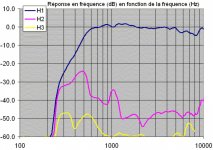
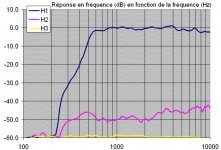
Please notice the increasing distortion on the 475PB below 1,3kHz (measurements taken on a fc500Hz Le Cléac'h profile horn - http://perso.orange.fr/francis.audio2/Comparaison_1pouce.pdf). It may be a source to the problems.


Last edited:
Hello,
I like very much my Radian's drivers (actually the cut is at 1,7Khz) but I'd like to try De250 with a lower cross over frequency, which is in your opinion the lower safe limit with a Seos12 horn and my 8w Amp using a 12db filter.
I red that the DE250 is a bit limited over 10Khz, may be necessary a super tweeter?Any suggestion?
Ciao
Guglielmo
Italy
I like very much my Radian's drivers (actually the cut is at 1,7Khz) but I'd like to try De250 with a lower cross over frequency, which is in your opinion the lower safe limit with a Seos12 horn and my 8w Amp using a 12db filter.
I red that the DE250 is a bit limited over 10Khz, may be necessary a super tweeter?Any suggestion?
Ciao
Guglielmo
Italy
Dr. Geddes style phase plug design stages. Optimized means all channels have OS curvature.
Hi, what are you using to simulate those designs?
And.. how do you interpret these sims?
Thanks!
I also liked the Radian when using it 1500Hz+... I then prefered it over the DE250. DE250 is a safe choice but as you say, it is a little limited in the top octaves. Personally I haven't missed a super tweeter with the DE250 but it could very well be a good thing to try.Hello,
I like very much my Radian's drivers (actually the cut is at 1,7Khz) but I'd like to try De250 with a lower cross over frequency, which is in your opinion the lower safe limit with a Seos12 horn and my 8w Amp using a 12db filter.
I red that the DE250 is a bit limited over 10Khz, may be necessary a super tweeter?Any suggestion?
Ciao
Guglielmo
Italy
The XO frequency and filter order should be selected to give a flat power response in the transition between your tweeter and woofer.
Hi, what are you using to simulate those designs?
And.. how do you interpret these sims?
I've used AxiDriver foir sims but I prefer compare stock plug with design plug by measuring directivity. I don't use sims anymore. This is for fun only.
I have tried the 475PB on SEOS15. In my setup the 475PB created a sibiliant sound when crossed-over lower than 1400Hz - the lower the more sibilant the sound. I used a relatively steep FIR filter. However I enjoyed the 475PB when crossed over 1500Hz+. I don't want to jump into conclusions but switching to DE250 was a lot more successful story.
Please notice the increasing distortion on the 475PB below 1,3kHz (measurements taken on a fc500Hz Le Cléac'h profile horn - http://perso.orange.fr/francis.audio2/Comparaison_1pouce.pdf). It may be a source to the problems.
View attachment 284930
View attachment 284931
Does the 475PB have a faraday ring?
Hmm.. only me that would like to have SEOS with larger throat?
I think a 15" two-way is big enough as it is, so a 1" throat is perfectly fine with me.
I would however like a driver truly comparable to a TAD 2002, without the 4K/pr price tag, with the same ~13 deg exit angle to match the SEOS.
Do you know any European alternative to Dayton RSS390HF-4?
The closest I can think of, would be the ATC SB75-375S08 or the Volt r3853
Last edited:
I don't know if the PB475 has Faraday ring, but that would normally have its advantage in the lowest frequencies, or?
I might have memorised a little wrong (long time since I tried the driver) - that the sibliance was pronounced already when trying 1400Hz XO. But I am confident that I had successfull results with XO at 1500. Yesterday I hooked the 475 to the SEOS 15 again and ran distorion tests indoor on the bare WG's. Measurement was done at 1m with a SPL of about 105db (have not SPL calibrated the rig). I observed that the driver has a mode at 1780Hz (48samples/octave). I then removed the backchamber and stuffed it into a damped tube and the overall distortion was severely reduced... will make a mod to the chamber and try the driver again with lower crossover after this. I did also run comparison with the DE250 and the distortion figures on this one may explain why I prefer the 475 when crossing over high
Regarding large throat on the SEOS (preferably SEOS18); By now I don't know of any alternative to the TAD2001/2002 and the 951 is a lot cheaper. I have never tried the TAD's but I do know that the upper mid and tweeter performance of the 951 outperforms any of the cheaper 1" I have tried. I can perfectly live with the beaming starting at 14/15kHz.
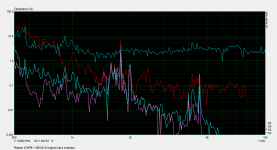
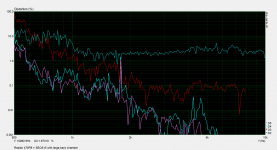
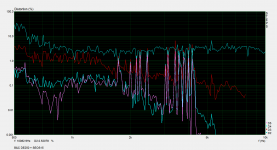

Edit: All tests done under exact same conditions
I might have memorised a little wrong (long time since I tried the driver) - that the sibliance was pronounced already when trying 1400Hz XO. But I am confident that I had successfull results with XO at 1500. Yesterday I hooked the 475 to the SEOS 15 again and ran distorion tests indoor on the bare WG's. Measurement was done at 1m with a SPL of about 105db (have not SPL calibrated the rig). I observed that the driver has a mode at 1780Hz (48samples/octave). I then removed the backchamber and stuffed it into a damped tube and the overall distortion was severely reduced... will make a mod to the chamber and try the driver again with lower crossover after this. I did also run comparison with the DE250 and the distortion figures on this one may explain why I prefer the 475 when crossing over high
Regarding large throat on the SEOS (preferably SEOS18); By now I don't know of any alternative to the TAD2001/2002 and the 951 is a lot cheaper. I have never tried the TAD's but I do know that the upper mid and tweeter performance of the 951 outperforms any of the cheaper 1" I have tried. I can perfectly live with the beaming starting at 14/15kHz.




Edit: All tests done under exact same conditions
Last edited:
- Home
- Group Buys
- Waveguides and horns
